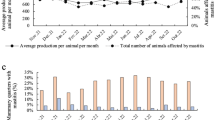Abstract
The objective of the surveys was to study fertility and productive performance of heifers and cows of the Red Steppe breed under different atmospheric pressure gradients of 725–750, 751–775, 774 mm Hg, and higher pressure gradients. On the days with the indicated atmospheric gradient frontiers, the heifer and cow insemination and milk yield control procedures with the analysis of the milk chemical composition were performed. It was ascertained that both cows and heifers demonstrated the highest conception rates at the first insemination (61.1 and 58%, respectively) on the days with the atmospheric pressure of 751–755 mm Hg. The maximum percentage of dry cows was registered during insemination of the animals on the indicated days. The highest daily milk yields were recorded in cows on the days of lactation, when the atmospheric pressure gradient did not exceed 775 mm Hg. Predominance of milk production over the milk yield obtained in the periods with the maximum atmospheric pressure comprised 3.1–3.6 kg (P > 0.99–0.999). The same trend could be observed in the dry matter content and the basic milk components. The survey outcomes show that conception rates and productive performance of the Red Steppe cattle are characterized by maximum values under the atmospheric pressure gradients (751–775 mm Hg) considered comfortable and suitable for animals.
Similar content being viewed by others
REFERENCES
Ulimbashev, M.B., Resistance, hematological indicators, and productive traits of brown Schwyz cows under distant-mountain grazing, S-kh. Biol., 2007, no. 42, pp. 97–100.
Ulimbashev, M.B. and Alagirova, Zh.T., Adaptive ability of Holstein cattle introduced into new habital conditions, Agric. Biol., 2016, vol. 51, no. 2, pp. 247–254.
Voronin, B.A. and Donnik, I.M., To the question of some problems import substitution of the food in Russian Federation, Global Science and Innovation Materials of the V International Scientific Conference, Chicago, 2015, pp. 93–97.
Donnik, I.M. and Shkuratova, I.A., Molecular-genetic and immunobiochemical markers in assessing the health of agricultural animals, Herald Russ. Acad. Sci., 2017, vol. 87, no. 2, pp. 139–142.
Shevhuzhev, A.F., Ulimbashev, M.B., Taov, I.Kh., Getokov, O.O., and Gosteva, E.R., Variability of hematological indices of Brown Swiss cattle with different technologies of keeping, Res. J. Pharm. Biol. Chem. Sci., 2017, vol. 8, no. 6, pp. 591–596.
De Rensis, F. and Scaramuzzi, R.J., Heat stress and seasonal effects on reproduction in the dairy cow a review, Theriogenology, 2003, no. 60, pp. 1139–1151.
Beloborodenko, T.A., Beloborodenko, A.M., and Beloborodenko, M.A., The morphofunctional state and correction of reproductive organs in physically inactive cows, Agrarn. Vestn. Urala, 2008, no. 11, pp. 28–29.
Volkova, S.V. and Meleshkina, S.R., Stress of farm animals as a response to adverse environmental conditions, Sovrem. Naukoemkie Tekhnol., 2008, no. 4, pp. 55–56.
Arbuzov, I.N., Masalov, V.N., Moshkina, S.V., Malakhova, N.A., and Krivoplyasov, E.I., The influence of technological factors on the productive and reproductive function in cattle, Uchenye Zap. Orlov. Gos. Univ., Ser.: Estestv. Tekh. Med. Nauki, 2014, no. 3, pp. 138–141.
Dickie, M.B., Sabo, P., and Schaller, A., Influence of meteorological events on obstetrical data in cattle and swine, J. Reprod. Fertil., 1994, no. 102, pp. 41–48.
Dahl, G.E. and Petitclerc, D., Management of photoperiod in the dairy herd for improved production and health, J. Anim. Sci., 2003, no. 81, pp. 11–17.
Collier, R.J., Dahl, G.E., and Van-Baale, M.J., Major advances associated with environmental effects on dairy cattle, J. Dairy Sci., 2006, no. 89, pp. 1244–1253.
Savsani, H.H., et al., Impact of climate on feeding, production and reproduction of animals, Agric. Rev., 2015, vol. 36, no. 1, pp. 26–36.
Natsional'naya tekhnologiya zamorazhivaniya i ispol’zovaniya spermy plemennykh bykov-proizvoditelei (National Technology for Freezing and Using Sperm of Breeding Bulls), Moscow, 2008.
Mascorenhas, R.D., Rios Vasjues, M.I.A.M., Horta, A.E.M., Robalo Silva, J., and Portugal, A.V., Seasonal variation in the ovarian activity of beef cows assessed by monitoring progesterone concentrations, Anim. Reprod. Sci., 1986, vol. 10, no. 4, pp. 251–259.
Slobodyanik, V.I., Cheskidova, L.V., and Terent’eva, T.N., Autoimmune processes in the body of cows with obstetric pathology, Veterinariya, 2004, no. 4, pp. 35–37.
Donnik, I.M., Shkuratova, I.A., and Vereshchak, N.A., Methodological approaches to assessing the environmental impact on animal health, Agrarn. Nauka Evro-Sev.-Vost., 2006, no. 8, pp. 169–173.
Britt, J.H., Cox, N.M., and Stevenson, J.S., Advances in reproduction in dairy cattle, J. Dairy Sci., 1981, no. 64, pp. 1378–1402.
Author information
Authors and Affiliations
Corresponding author
Ethics declarations
Conflict of interest. The authors declare that they have no conflict of interest.
Statement of welfare of animals. All applicable international, national, and/or institutional guidelines for the care and use of animals were followed. The article does not concern any researches using animals as objects.
Additional information
Translated by O. Zhiryakova
About this article
Cite this article
Ulimbashev, M.B., Huranov, A.M., Krasnova, O.A. et al. Fertility and Productive Performance of Cattle at Different Levels of Atmospheric Pressure. Russ. Agricult. Sci. 46, 171–174 (2020). https://doi.org/10.3103/S1068367420020196
Received:
Revised:
Accepted:
Published:
Issue Date:
DOI: https://doi.org/10.3103/S1068367420020196




